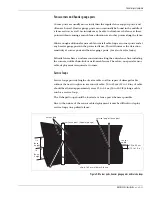
Perimeter layout guidelines
Intelli-FLEX II product guide • • • 4 - 11
Fence corners and heavier gauge posts
Corner posts are usually more sturdy than the regular fence support posts, and
often are braced. Heavier gauge posts can occasionally be found in the middle of
a fence section, as well. An intruder may be able to climb over the fence at these
points without causing as much fence vibration as at other points along the fence.
Allow enough additional sensor cable to install cable loops at corner posts and at
any heavier gauge posts in the protected fence. This will increase the detection
sensitivity at corner posts and heavier gauge posts. (See also
)
Palisade fences have a uniform construction along the entire fence line including
the corners, unlike chain-link or weld-mesh fences. Therefore, no special sensor
cable deployment is required at corners.
Service loops
Service loops provide lengths of extra cable to allow repair of damaged cable
without the need to splice in a section of cable. 30 to 45 cm (12 to 18 in.) of cable
should be allotted approximately every 15 to 61 m (50 to 200 ft.) along a cable
run for a service loop.
The U-shaped loop should be located at a fence post whenever possible.
Due to the nature of the sensor cable deployment, it may be difficult to deploy
service loops on a palisade fence.
Figure 4-8 Corner posts, heavier gauge posts, and service loops
corner fence post (heavier gauge)
sensor
cable
chain-link or weld mesh fence
corner loop
30 to 45 cm
(12 to 18 in.)
service loop at fence post
1/4
1/4
fence
height
fence
height
















































